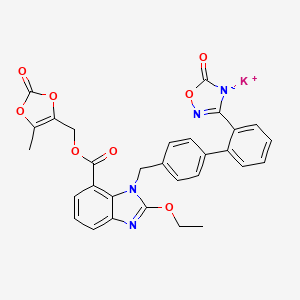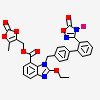Azilsartan Kamedoxomil
- Azilsartan kamedoxomil
- 863031-24-7
- Azilsartan medoxomil potassium
- UNII-WEC6I2K1FC
- WEC6I2K1FC
- Create:2008-02-05
- Modify:2025-01-18

- Azilsartan kamedoxomil
- 863031-24-7
- Azilsartan medoxomil potassium
- UNII-WEC6I2K1FC
- WEC6I2K1FC
- Azilsartan kamedoxomil [USAN]
- CHEBI:68847
- Azilsartan Kamedoxomil (>90%)
- DTXSID70235483
- Azilsartan kamedoxomil;TAK 491 monopotassium
- Azilsartan kamedoxomil (USAN)
- AZILSARTAN KAMEDOXOMIL (MART.)
- AZILSARTAN KAMEDOXOMIL [MART.]
- Azilsartan Medoxomil Monopotassium Salt
- 1H-BENZIMIDAZOLE-7-CARBOXYLIC ACID, 1-((2'-(2,5-DIHYDRO-5-OXO-1,2,4-OXADIAZOL-3-YL)(1,1'-BIPHENYL)-4-YL)METHYL)-2-ETHOXY-, (5-METHYL-2-OXO-1,3-DIOXOL-4-YL)METHYL ESTER, POTASSIUM SALT
- Potassium 3-(4'-((2-ethoxy-7-(((5-methyl-2-oxo-1,3-dioxol-4-yl)methoxy)carbonyl)-1H-benzimidazol-1-yl)methyl)biphenyl-2-yl)-5-oxo-1,2,4-oxadiazol-4(5H)-ide
- potassium;(5-methyl-2-oxo-1,3-dioxol-4-yl)methyl 2-ethoxy-3-[[4-[2-(5-oxo-1-oxa-2-aza-4-azanidacyclopent-2-en-3-yl)phenyl]phenyl]methyl]benzimidazole-4-carboxylate
- potassium 3-(4'-((2-ethoxy-7-(((5-methyl-2-oxo-1,3-dioxol-4-yl)methoxy)carbonyl)-1H-benzimidazol-1-yl)methyl)biphenyl-2-yl)-5-oxo-1,2,4-oxadiazol-4-ide
- potassium 3-{4'-[(2-ethoxy-7-{[(5-methyl-2-oxo-1,3-dioxol-4-yl)methoxy]carbonyl}-1H-benzimidazol-1-yl)methyl]biphenyl-2-yl}-5-oxo-1,2,4-oxadiazol-4-ide
- Edarbi (TN)
- Azilsartan kamedoxomil?
- SCHEMBL967310
- CHEMBL2103795
- DTXCID70157974
- AZILSARTAN KAMEDOXOMIL [MI]
- AKOS025401854
- AZILSARTAN KAMEDOXOMIL [WHO-DD]
- AC-26396
- DA-61451
- AZILSARTAN KAMEDOXOMIL [ORANGE BOOK]
- D08865
- Q27292593
- 1H-Benzimidazole-7-carboxylic acid, 1-((2'-(2,5-dihydro-5-oxo-1,2,4-oxadiazol-3- yl)(1,1'-biphenyl)-4-yl)methyl)-2-ethoxy-, (5-methyl-2-oxo-1,3-dioxol-4-yl)methyl ester, potassium salt
- POTASSIUM 3-(4'-((2-ETHOXY-7-(((5-METHYL-2-OXO-1,3-DIOXOL-4-YL)METHOXY)CARBONYL)- 1H-BENZIMIDAZOL-1-YL)METHYL)BIPHENYL-2-YL)-5-OXO-1,2,4-OXADIAZOL-4(5H)-IDE
Azilsartan (has active moiety)
- Azilsartan kamedoxomil; chlorthalidone (component of)

H361 (100%): Suspected of damaging fertility or the unborn child [Warning Reproductive toxicity]
H362 (100%): May cause harm to breast-fed children [Reproductive toxicity, effects on or via lactation]
P203, P260, P263, P264, P270, P280, P318, P405, and P501
(The corresponding statement to each P-code can be found at the GHS Classification page.)
Patents are available for this chemical structure:
https://patentscope.wipo.int/search/en/result.jsf?inchikey=IHWFKDWIUSZLCJ-UHFFFAOYSA-M
- ChEBIAzilsartan kamedoxomilhttps://www.ebi.ac.uk/chebi/searchId.do?chebiId=CHEBI:68847
- Open TargetsLICENSEDatasets generated by the Open Targets Platform are freely available for download.https://platform-docs.opentargets.org/licenceAZILSARTAN KAMEDOXOMILhttps://platform.opentargets.org/drug/CHEMBL2103795
- ChEMBLLICENSEAccess to the web interface of ChEMBL is made under the EBI's Terms of Use (http://www.ebi.ac.uk/Information/termsofuse.html). The ChEMBL data is made available on a Creative Commons Attribution-Share Alike 3.0 Unported License (http://creativecommons.org/licenses/by-sa/3.0/).http://www.ebi.ac.uk/Information/termsofuse.htmlChEMBL Protein Target Treehttps://www.ebi.ac.uk/chembl/g/#browse/targets
- Drug Gene Interaction database (DGIdb)LICENSEThe data used in DGIdb is all open access and where possible made available as raw data dumps in the downloads section.http://www.dgidb.org/downloadsAZILSARTAN KAMEDOXOMILhttps://www.dgidb.org/drugs/rxcui:1294597
- ChemIDplusAzilsartan kamedoxomil [USAN]https://pubchem.ncbi.nlm.nih.gov/substance/?source=chemidplus&sourceid=0863031247ChemIDplus Chemical Information Classificationhttps://pubchem.ncbi.nlm.nih.gov/source/ChemIDplus
- EPA DSSToxAzilsartan kamedoxomilhttps://comptox.epa.gov/dashboard/DTXSID70235483CompTox Chemicals Dashboard Chemical Listshttps://comptox.epa.gov/dashboard/chemical-lists/
- European Chemicals Agency (ECHA)LICENSEUse of the information, documents and data from the ECHA website is subject to the terms and conditions of this Legal Notice, and subject to other binding limitations provided for under applicable law, the information, documents and data made available on the ECHA website may be reproduced, distributed and/or used, totally or in part, for non-commercial purposes provided that ECHA is acknowledged as the source: "Source: European Chemicals Agency, http://echa.europa.eu/". Such acknowledgement must be included in each copy of the material. ECHA permits and encourages organisations and individuals to create links to the ECHA website under the following cumulative conditions: Links can only be made to webpages that provide a link to the Legal Notice page.https://echa.europa.eu/web/guest/legal-noticeAzilsartan Medoxomil Potassium (TAK-491)https://echa.europa.eu/substance-information/-/substanceinfo/100.239.021Azilsartan Medoxomil Potassium (TAK-491) (EC: 810-708-9)https://echa.europa.eu/information-on-chemicals/cl-inventory-database/-/discli/details/248492
- FDA Global Substance Registration System (GSRS)LICENSEUnless otherwise noted, the contents of the FDA website (www.fda.gov), both text and graphics, are not copyrighted. They are in the public domain and may be republished, reprinted and otherwise used freely by anyone without the need to obtain permission from FDA. Credit to the U.S. Food and Drug Administration as the source is appreciated but not required.https://www.fda.gov/about-fda/about-website/website-policies#linkingAZILSARTAN KAMEDOXOMILhttps://gsrs.ncats.nih.gov/ginas/app/beta/substances/WEC6I2K1FC
- ClinicalTrials.govLICENSEThe ClinicalTrials.gov data carry an international copyright outside the United States and its Territories or Possessions. Some ClinicalTrials.gov data may be subject to the copyright of third parties; you should consult these entities for any additional terms of use.https://clinicaltrials.gov/ct2/about-site/terms-conditions#Use
- DailyMed
- Drugs@FDALICENSEUnless otherwise noted, the contents of the FDA website (www.fda.gov), both text and graphics, are not copyrighted. They are in the public domain and may be republished, reprinted and otherwise used freely by anyone without the need to obtain permission from FDA. Credit to the U.S. Food and Drug Administration as the source is appreciated but not required.https://www.fda.gov/about-fda/about-website/website-policies#linkingAZILSARTAN KAMEDOXOMILhttps://www.accessdata.fda.gov/scripts/cder/daf/
- EU Clinical Trials Register
- FDA Orange BookLICENSEUnless otherwise noted, the contents of the FDA website (www.fda.gov), both text and graphics, are not copyrighted. They are in the public domain and may be republished, reprinted and otherwise used freely by anyone without the need to obtain permission from FDA. Credit to the U.S. Food and Drug Administration as the source is appreciated but not required.https://www.fda.gov/about-fda/about-website/website-policies#linking
- KEGGLICENSEAcademic users may freely use the KEGG website. Non-academic use of KEGG generally requires a commercial licensehttps://www.kegg.jp/kegg/legal.htmlUSP drug classificationhttp://www.genome.jp/kegg-bin/get_htext?br08302.kegAnatomical Therapeutic Chemical (ATC) classificationhttp://www.genome.jp/kegg-bin/get_htext?br08303.kegTarget-based classification of drugshttp://www.genome.jp/kegg-bin/get_htext?br08310.keg
- National Drug Code (NDC) DirectoryLICENSEUnless otherwise noted, the contents of the FDA website (www.fda.gov), both text and graphics, are not copyrighted. They are in the public domain and may be republished, reprinted and otherwise used freely by anyone without the need to obtain permission from FDA. Credit to the U.S. Food and Drug Administration as the source is appreciated but not required.https://www.fda.gov/about-fda/about-website/website-policies#linkingAZILSARTAN KAMEDOXOMILhttps://www.fda.gov/drugs/drug-approvals-and-databases/national-drug-code-directory
- NCI Thesaurus (NCIt)LICENSEUnless otherwise indicated, all text within NCI products is free of copyright and may be reused without our permission. Credit the National Cancer Institute as the source.https://www.cancer.gov/policies/copyright-reuseNCI Thesaurushttps://ncit.nci.nih.gov
- NLM RxNorm TerminologyLICENSEThe RxNorm Terminology is created by the National Library of Medicine (NLM) and is in the public domain and may be republished, reprinted and otherwise used freely by anyone without the need to obtain permission from NLM. Credit to the U.S. National Library of Medicine as the source is appreciated but not required. The full RxNorm dataset requires a free license.https://www.nlm.nih.gov/research/umls/rxnorm/docs/termsofservice.htmlazilsartan kamedoxomilhttps://rxnav.nlm.nih.gov/id/rxnorm/1294597
- Wikidataazilsartan kamedoxomilhttps://www.wikidata.org/wiki/Q27292593
- PubChem
- GHS Classification (UNECE)GHS Classification Treehttp://www.unece.org/trans/danger/publi/ghs/ghs_welcome_e.html
- MolGenieMolGenie Organic Chemistry Ontologyhttps://github.com/MolGenie/ontology/
- PATENTSCOPE (WIPO)SID 393705975https://pubchem.ncbi.nlm.nih.gov/substance/393705975


 CID 135409642 (Azilsartan medoxomil)
CID 135409642 (Azilsartan medoxomil) CID 5462222 (Potassium)
CID 5462222 (Potassium)